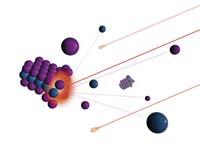Breaking Machine Working

The recent news is that the giant accelerator LHC has started a scientific program. In fact, it was inaugurated in the spring of 2008, but there was a serious breakdown that forced physicists to suspend work until the repair of the giant machine. It was launched again in November 2009 and in spring 2010 scientific experiments have begun.
What will they do? What is the use of this giant accelerator? There are two types of response. One is a very prose answer: it serves to investigate the origin of the universe, etc., for example, what happened in the next moments of the Big Bang. But the other answer is clearer for those who want to know what the machine does: it is a great machine to break objects.
Objects that break are not objects that we see and use in our daily lives, but form their atoms. In the accelerator, they catch speed and cause the particles to crash. The work of physicists is to identify the fragments that are generated in the shocks to obtain information about the matter.
Why do you need a large machine to do it? Because it takes a lot of energy to trigger these impacts. It is understood why with examples of everyday life. Imagine that we want to know what a radio device is made of.
To achieve this it is possible to break the apparatus to distribute it in pieces. Thrown against the land, for example. Several cables, circuits, speaker, etc. will appear. These are the ingredients. But you can move forward. What is the speaker made of, for example? To know, as in the previous case, one option is to break that piece. However, a new breakage system is needed. If in the previous experiment has not broken, pulling back against the ground does not break. Now more energy is needed. If we play with a hammer, for example, we will have the speaker components in view. Magnets, a thread membrane, etc. will be distributed. But you can move forward again. What is the magnet made of? The same thing: we have to break with more energy.
Against the forces
This is what physicists do to investigate the basic components of matter. To investigate atoms, they break with an increasing energy and analyze the fragments that are generated.
In fact, breaking an atom does not require much energy. To free the electrons from the influence of the atom, which is a way of breaking the atom, only a small electric force is needed, which sometimes occurs with the mere presence of other atoms around it. According to the atom, releasing electrons is a process that requires more energy, but we still refer to measures that can be created by a household appliance, such as the energy that the cathodic tube of an old television makes.
However, the energy needed to break the atom's core itself is very large. In the first atomic bombs, to break the nuclei of uranium or plutonium, the explosive RDX was used (in the nuclear plants the nuclei of uranium are bombarded with neutrons to break).
Following a step forward, to know what the particles that make up the nucleus are formed, we enter a field of very high energy levels. Physicists of the 1960s claimed that neutrons and protons are made up of quarks. To affirm that this is so, the nuclei of atoms must be broken with a very high energy.
Leon M. This was achieved by physicist Lederman in 1977, using an accelerator from the Fermilab laboratory. Lederman won the Nobel Prize, not for that, but for research with neutrinos. But using an accelerator, he detected a b quark.
The question is: Can we still move forward? Can quarkas be broken to see what they are formed from? The answer is "no." The LHC accelerator is the machine that currently produces the most energy impacts. And, so to speak, it provides enough energy to free quarkas, but not to break. And despite making a machine more "strong" than the LHC, you can't reach the level of energy that would break the quarks. This energy is increased by several orders of magnitude. It is not possible without more.
Another thing is that the pieces that are generated in these shocks are not permanent, they are undone. A free neutron lasts only 15 minutes before disintegration. When disintegrating it gives a proton, an electron and a neutrino; if the physicists detect these three particles between the fragments, they can conclude that a neutron has occurred. Quarks last much less (about 10-25 seconds). And if we could release the components of the quarks, they would last much less time, and their disintegrated products would also dissolve very quickly.
That's why, to some extent, we've played up with the LHC accelerator. It can be improved and, of course, there are many experiments at the energy level it gives. Another accelerator can also be made bigger, but physicists know that they will not be able to obtain particles smaller than quarka. We are on the border.





